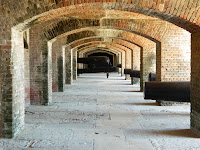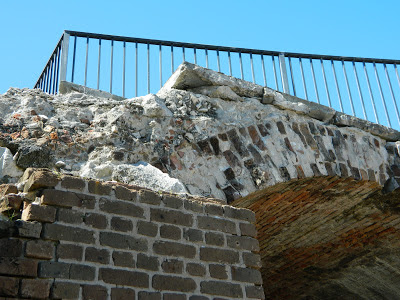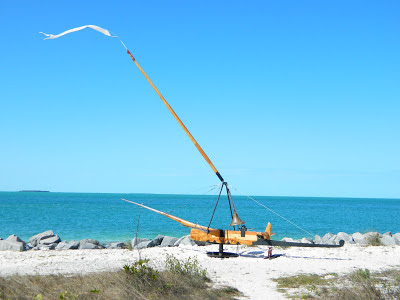Fort Zachary Taylor (1846-1947) - Construction of this fort began in Jun 1845 and was essentially complete in 1866. Named for recently deceased President Zachary Taylor it became known as Fort Zachary Taylor (now as Fort Taylor or Fort Zach)
Black Smith Shop outside the Fort
from the chimney
Fort Taylor was designed as a three tiered, double casemated, Third System brick and masonry fort in the shape of a trapezoid. The land face was 495' long and the seaward curtains were 255' long each. There were four bastions, three seaward facing curtains and one land facing gorge.
The fort was located off shore about 1000' on the southwestern side of Key West Island, Florida.
The landward side of the fort was to be protected by a large casemated coverface located on Key West itself, directly across from the fort with a drawbridge connecting them. The coverface was to have mounted 48 guns but was never built.
Construction began in Jun 1845 by the end of 1860 the fort was ready for occupancy and by 1866 it was completed. When completed the Fort could mount 140 cannons and house 450 men. The armament varied over the years but by the end of the U.S. Civil War it mounted some of the largest smoothbore cannons the Union had and the best rifled Parrot guns available.
Later modifications to the fort during the Endicott Period reduced the fort to a single tier of casemates to reduce the possibility of enemy damage to the brick walls.
Key West Barracks, built in 1831, provided a support facility in Key West during the construction and garrisoning of Fort Taylor.
The original flag in 1866 only had 35 stars.
Alaska may have shown up on a map as Russian America.
The brig (jail)
SE anchorage at Christmas Tree Island viewed from FZT
Two Martello Towers were constructed along the eastern shore of Key West as defensive structures for the fort itself. Each tower was fronted by a casemated battery with positions for 14 guns. The towers were square structures with a single tier of two story casemates. On the top of each tower was a barbette tier with four gun emplacements.
The two towers were called Martello Tower 1 (West) and Martello Tower 2 (East). Tower 1 was located near the corner of Atlantic Blvd. and White Street. During the Endicott Period Tower 1 was modified and Battery Inman placed where the frontal casemates were originally located. Tower 2 is located at the southeastern end of South Roosevelt Blvd.
Outdated armaments buried within lower casemates
Cannon mounts atop the garisson
Ventilation
Mechanical lift
The sign said "No standing" not crawling!
current view from the casemate
below the casemate window
Rodman Gun in casemate.
These were smooth bore and designed to fire the infamous cannon ball.
FZT has proven to house the largest collection of Civil War armaments.
Most of which were buried within the casements during the Endicott period.
Seacoast Mortar fired a large arc over the walls
smooth bore and rifled bore cannons
Parrot Rifled Gun, increased penetration from 6 inches into brick and mortar to 6-7 FEET!
It weighed a massive 26,710 pounds and shot 300 pound shells
Current condition of the fort. Two thirds is currently closed down due to possible collapse.
Endicott Period: Fort Taylor was upgraded during the Endicott Period with 10 reinforced concrete gun batteries in and around the fort proper. The top two tiers of casemates were removed and two newer coastal artillery batteries were built into the South and West casemates. Battery Osceola was built into the South casemates and Battery Adair was built into the West casemates. Fill for the cavities was provided from destroyed casemates and obsolete artillery pieces. Excavations in the 1960s and 1970s recovered many of the artillery pieces now displayed and exposed others. General Order 43, 4 Apr 1900, designated the entire military reservation around the old Fort Taylor as Fort Taylor, encompassing the new batteries.
All ten batteries were started between 1897 and 1904 and all were completed by 1904 and accepted for service by 1906. Accepted for service did not necessarily mean that they were armed, and it was 1917 before all were armed. Battery Inman was built into the West Martillo Tower.
World War II brought the Coast Artillery Modernization Program to Fort Taylor and Key West. Two standard 200 series batteries, Battery 231 and Battery 232 were built and finished but Battery 231 never received it's gun tubes. The plan was to replace and deactivate Battery Seminole and Battery Osceola as soon as the two 200 series batteries were complete. Two Anti-Torpedo Motor Boat (AMTB) batteries, Battery AMTB 5 and Battery AMTB 6, were installed with the dual mission of anti-aircraft and torpedo motor boat defense. Each AMTB battery had two shielded 90mm fixed gun positions and two 37mm guns on mobile carriages.
In addition to these batteries, Battery Ford and Battery Inman remained operational through the end of the war. Anti-aircraft guns were install on Battery Adair in 1943 and at other locations. The guns and carriages for Battery Seminole and Battery Osceola were sold for salvage and removed in 1944. The remaining Endicott Period batteries had been deactivated by the beginning of World War II.
Additional defensive equipment including searchlights and radar were employed at Fort Taylor and sub-posts.
South West wall
Looking toward the North West Bastion.
Looking from inside the North West Bastion
North West wall
Current: The fort site was transferred to the Navy in 1947 and was used a storage yard for scrap metal. The Department of the Interior took over the property until it was deeded to the State of Florida in 1976. The fort is now a Florida State Park.
We did not get our promised 12 noon guided tour so we had to take pictures and look up all the information. Dad had planned on me taking notes and writing from them to make this report.
Loomings (Moby Dick), by William Bennett
Steel Blooms, by Jacquelyn Sanchez
Looking South West from the beach at FZT
Looking East and North West from the beach at FZT
My classroom for the day!
*pictures by us, information from fort.wiki





























































No comments:
Post a Comment